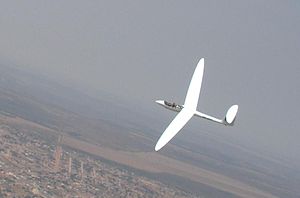| Schubert P-1 | |
|---|---|

| |
| P-1 flying over Luziânia, 2008. | |
| Role | SailplaneType of aircraft |
| National origin | Brazil |
| Designer | Ekkehard Schubert |
| First flight | 3 Mar 2002 |
| Number built | 1 |
| Developed from | ITA P-1 |
The Schubert P-1 is a sailplane produced in Brazil, designed by the aeronautical engineer Ekkehard Schubert.
Design and development
The fuselage construction is made of FRP, in single shell, with two caverns for fixing the wing and the landing gear. The fuselage structure includes the drift structure, whose surface is made of FRP and PVC foam sandwich. The rear spar of the drift, with FRP tables (uni-directional fabric or roving) and FRP sandwich core supported by PVC foam, closes the entire structure. The wing-fuselage connection is made by means of the two caverns, in which the half-wings are connected by means of two wing-wing connecting pins.
The three-dimensional geometry of the fuselage cabin is derived from a two-dimensional profile, accommodated in the flow of the wing. Negative camber at -1.7 m, at the wing tip, measured at the aileron articulation axis. Schempp-Hirth brakes on the extrados.
The first flight of the P1 was on March 3, 2002, at CTA in São José dos Campos.
Specifications
General characteristics
- Crew: 2
- Length: 8.3 m (27 ft 3 in)
- Wingspan: 16.5 m (54 ft 2 in)
- Height: 1.74 m (5 ft 9 in)
- Wing area: 16.01 m (172.3 sq ft)
- Airfoil: NACA 663-018 at root NACA 662-015 at tip
- Empty weight: 320 kg (705 lb)
- Gross weight: 520 kg (1,146 lb)
Performance
- Maximum speed: 156 km/h (97 mph, 84 kn)
- Maximum glide ratio: 1:33
- Rate of sink: 0.6 m/s (120 ft/min)
- Wing loading: 32.0 kg/m (6.6 lb/sq ft) maximum
See also
Aircraft of comparable role, configuration, and era
References
- Yuri Vasconcelos. "Berçário de aviões" (PDF). São Paulo Research Foundation. Retrieved 13 November 2021.
- "Federação Brasileira de Voo a Vela traz competição regional a Bebedouro". G1. Retrieved 13 November 2021.
- "Planador com concepção nacional". São Paulo Research Foundation. Retrieved 13 November 2021.
External links
This article on an aircraft of the 2000s is a stub. You can help Misplaced Pages by expanding it. |